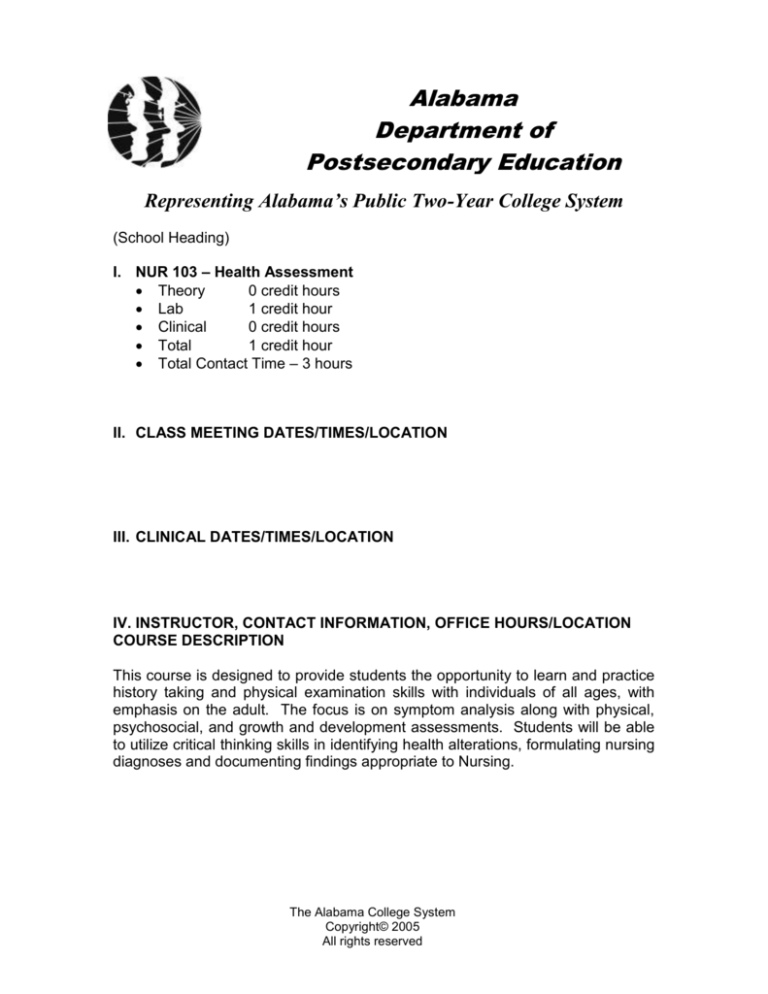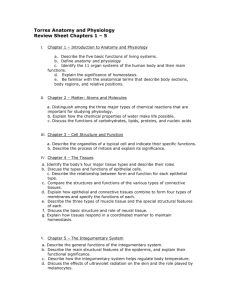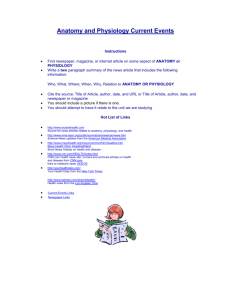
Alabama
Department of
Postsecondary Education
Representing Alabama’s Public Two-Year College System
(School Heading)
I. NUR 103 – Health Assessment
Theory
0 credit hours
Lab
1 credit hour
Clinical
0 credit hours
Total
1 credit hour
Total Contact Time – 3 hours
II. CLASS MEETING DATES/TIMES/LOCATION
III. CLINICAL DATES/TIMES/LOCATION
IV. INSTRUCTOR, CONTACT INFORMATION, OFFICE HOURS/LOCATION
COURSE DESCRIPTION
This course is designed to provide students the opportunity to learn and practice
history taking and physical examination skills with individuals of all ages, with
emphasis on the adult. The focus is on symptom analysis along with physical,
psychosocial, and growth and development assessments. Students will be able
to utilize critical thinking skills in identifying health alterations, formulating nursing
diagnoses and documenting findings appropriate to Nursing.
The Alabama College System
Copyright© 2005
All rights reserved
Health Assessment
NUR 103
V. PREREQUISITE(S)/COREQUISITE(S)
Prerequisites:
BIO 103 – Principles of Biology I (or satisfactory performance on the
Alabama College System approved placement exam) NOTE: Only
required if student is taking BIO 201 and 202 sequences.
Co-Requisites:
NUR 102 – Fundamentals of Nursing
NUR 104 – Introduction to Pharmacology
BIO 201 – Human Anatomy and Physiology or NUR 101 – Body Structure
and Function (if selected by PN students)
MTH 116 – Mathematical Applications (or higher level)
VI. TEXTBOOK(S) AND OTHER LEARNING RESOURCES
VII.
Competencies/Objectives
Explain the characteristics of growth and development of individuals
throughout the lifespan.
Obtain a health history to gather subjective data.
Perform a systematic (head to toe) physical assessment to gather
objective data.
Document assessments.
MODULE A – GROWTH AND DEVELOPMENT THROUGHOUT THE
LIFESPAN
A1.0 Explain the characteristics of growth and development of individuals
throughout the lifespan.
A1.1 This module is evaluated cognitively.
A1.1.1 Define key terms associated with growth and development.
A1.1.2 Describe common developmental theories associated with
growth and development.
A1.1.3 Describe normal growth and development characteristics
throughout the lifespan.
ACS © 2005
All Rights Reserved
2
Health Assessment
NUR 103
MODULE B – HEALTH HISTORY
B1.0 Obtain a health history to gather subjective data.
B1.1 Obtain comprehensive health history using interview
techniques.
B1.1.1 Identify factors influencing the interview process.
B1.1.2 Identify stages of the interview process.
B1.1.3 Identify interview techniques.
B1.1.4 Identify elements of a comprehensive health history.
B2.0 Document assessment.
B2.1 Given information relative to a client’s health history,
document and report the health history.
B2.1.1 Explain the importance of documenting and reporting health
history.
B2.1.2 Identify required elements of documenting health history.
B2.1.3 Explain the process of documenting health history.
MODULE C – GENERAL SURVEY
C1.0 Perform a systematic (head to toe) physical assessment to gather
objective data.
C1.1 Conduct a general survey.
C1.1.1 Define components of the general survey.
C1.1.2 Explain the process of conducting a general survey.
C1.1.3 Explain the process of conducting a Mini Mental Status
Exam.
C1.1.4 Recognize normal findings.
C1.2 Use physical assessment techniques.
C1.2.1 Identify physical assessment techniques.
C1.2.2 Explain the procedures for physical assessment techniques.
C2.0 Document results of health assessment.
C2.1
Given information relative to a client’s physical assessment,
document and report physical assessment.
ACS © 2005
All Rights Reserved
3
Health Assessment
NUR 103
MODULE D – PHYSICAL ASSESSMENT OF HEENT
D1.0 Perform a systematic (head to toe) physical assessment to gather
objective data.
D1.1 Perform a physical assessment of the head, eyes, ears, nose
and throat.
D1.1.1 Define terminology related to assessment of head, eyes,
ears, nose, and throat (HEENT).
D1.1.2 Describe anatomy and physiology of head and neck.
D1.1.3 Identify equipment.
D1.1.4 Identify positioning.
D1.1.5 Identify techniques.
D1.1.6 Explain the process of performing a head/neck physical
assessment.
D1.1.7 Recognize normal findings.
D2.0 Document results of health assessment.
D2.1 Given information relative to a physical assessment,
document and report findings.
MODULE E – PHYSICAL ASSESSMENT OF INTEGUMENTARY SYSTEM
E1.0 Perform a systematic (head to toe) physical assessment to gather
objective data.
E1.1 Perform a physical assessment of the integumentary system.
E1.1.1 Define terminology related to assessment of the
integumentary system.
E1.1.2 Describe anatomy and physiology of integumentary system.
E1.1.3 Identify equipment.
E1.1.4 Identify positioning.
E1.1.5 Identify techniques.
E1.1.6 Explain the process of performing an assessment of the
integumentary system.
E1.1.7 Recognize normal assessment findings.
E2.0 Document results of health assessment.
E2.1 Document and report assessment of the integumentary
system.
ACS © 2005
All Rights Reserved
4
Health Assessment
NUR 103
MODULE F – PHYSICAL ASSESSMENT OF THE RESPIRATORY SYSTEM
F1.0 Perform a systematic (head to toe) physical assessment to gather
objective data.
F1.1 Perform a physical assessment of the respiratory system.
F1.1.1 Define terminology related to assessment of the respiratory
system.
F1.1.2 Describe anatomy and physiology of the respiratory system.
F1.1.3 Identify equipment.
F1.1.4 Identify positioning.
F1.1.5 Identify techniques.
F1.1.6 Explain the process of performing an assessment of the
respiratory system.
F1.1.7 Recognize normal assessment findings.
F2.0 Document results of health assessment.
F2.1 Document and report assessment of the respiratory system.
MODULE G – PHYSICAL ASSESSMENT OF CIRCULATORY/LYMPHATIC
SYSTEM
G1.0 Perform a systematic (head to toe) physical assessment to gather
objective data.
G1.1 Perform a physical assessment of the circulatory/lymphatic
system.
G1.1.1 Define terminology related to assessment of the
circulatory/lymphatic system.
G1.1.2 Describe anatomy and physiology of the
circulatory/lymphatic system.
G1.1.3 Identify equipment.
G1.1.4 Identify positioning.
G1.1.5 Identify techniques.
G1.1.6 Explain the process of performing an assessment of the
circulatory/lymphatic system.
G1.1.7 Recognize normal assessment findings.
G2.0 Document results of health assessment.
G2.1 Document and report assessment of the circulatory/lymphatic
system.
ACS © 2005
All Rights Reserved
5
Health Assessment
NUR 103
MODULE H – PHYSICAL ASSESSMENT OF THE BREAST AND AXILLAE
H1.0 Perform a systematic (head to toe) physical assessment to gather
objective data.
H1.1 Using clinical simulations or models, perform a physical
assessment of the breast and axillae.
H1.1.1 Define terminology related to assessment of the breast and
axillae.
H1.1.2 Describe anatomy and physiology of the breast and axillae.
H1.1.3 Identify equipment.
H1.1.4 Identify positioning.
H1.1.5 Identify techniques.
H1.1.6 Explain the process of performing an assessment of the
breast and axillae.
H1.1.7 Recognize normal assessment findings.
H1.2 Teach the technique of breast self-examination for males and
females.
H1.2.1 Explain the steps for performing the breast self-examination
for males and females.
H2.0 Document results of health assessment.
H2.1 Document and report assessment of the breast and axillae.
MODULE I – PHYSICAL ASSESSMENT OF THE ABDOMEN
I1.0 Perform a systematic (head to toe) physical assessment to gather
objective data.
I1.1 Perform a physical assessment of the abdomen.
I1.1.1 Define terminology related to assessment of the abdomen.
I1.1.2 Describe anatomy and physiology of the abdomen.
I1.1.3 Identify equipment.
I1.1.4 Identify positioning.
I1.1.5 Identify techniques.
I1.1.6 Explain the process of performing an assessment of the
abdomen.
I1.1.7 Recognize normal assessment findings.
I2.0 Document results of health assessment.
I2.1 Document and report assessment of the abdomen.
ACS © 2005
All Rights Reserved
6
Health Assessment
NUR 103
MODULE J – PHYSICAL ASSESSMENT OF THE REPRODUCTIVE SYSTEM
J1.0 Perform a systematic (head to toe) physical assessment to gather
objective data.
J1.1 Using clinical simulations or models, assist with performing a
physical assessment of the male and female reproductive
systems.
J1.1.1 Define terminology related to assessment of the male and
female reproductive systems.
J1.1.2 Describe anatomy and physiology of the male and female
reproductive systems.
J1.1.3 Identify equipment.
J1.1.4 Identify positioning.
J1.1.5 Identify techniques.
J1.1.6 Explain the process of assisting with assessment of male
and female reproductive systems.
J1.1.7 Recognize normal assessment findings.
J1.1.8 Explain the examination of the rectum, perineum, and
prostate
J1.2 Teach the technique of testicular self-examination for males.
J1.2.1 Explain the testicular self-examination.
J2.0 Document results of health assessment.
J2.1 Document and report assessment of the male and female
reproductive system.
MODULE K – PHYSICAL ASSESSMENT OF THE MUSCULOSKELETAL
SYSTEM
K1.0 Perform a systematic (head to toe) physical assessment to gather
objective data.
K1.1 Perform a physical assessment of the musculoskeletal
system.
K1.1.1 Define terminology related to assessment of the
musculoskeletal system.
K1.1.2 Describe anatomy and physiology of the musculoskeletal
system.
K1.1.3 Identify equipment.
K1.1.4 Identify positioning.
K1.1.5 Identify techniques.
K1.1.6 Explain the process of performing an assessment of the
musculoskeletal system.
K1.1.7 Identify normal assessment findings.
K2.0 Document results of health assessment.
K2.1 Document and report assessment of the musculoskeletal
system.
ACS © 2005
All Rights Reserved
7
Health Assessment
NUR 103
MODULE L – PHYSICAL ASSESSMENT OF THE NEUROLOGICAL SYSTEM
L1.0 Perform a systematic (head to toe) physical assessment to gather
objective data.
L1.1 Perform a physical assessment of the neurological system.
L1.1.1 Define terminology related to assessment of the neurological
system.
L1.1.2 Describe anatomy and physiology of the neurological
system.
L1.1.3 Identify equipment.
LJ1.1.4 Identify positioning.
L1.1.5 Identify techniques.
L1.1.6 Explain the process of performing an assessment of the
neurological system.
L1.1.7 Identify normal assessment findings.
L2.0 Document results of health assessment.
L2.1 Document and report assessment of the neurological system.
ACS © 2005
All Rights Reserved
8
Health Assessment
NUR 103
COURSE CONTENT OUTLINE
MODULE A – GROWTH AND DEVELOPMENT THROUGHOUT THE LIFE
SPAN
Pediatric
Adult
Geriatric
MODULE B – HEALTH HISTORY
Obtaining a health history
Interview techniques
Comprehensive health history
o Biographic data
o Chief complaint
o History of present illness (symptom analysis)
o Past medical history
o Alternative therapies
o Cultural influences
Normal assessment findings
Documenting and reporting assessment
MODULE C – CLIENT GENERAL SURVEY
Conducting a general survey
Components
o General appearance
o Gait
o Posture
o Vital signs
o Speech
o Signs of distress
o Body type
o Hygiene
o Height/weight/body mass index
o Ethnicity
o Mental status and level of consciousness
Procedure for general survey
Mini Mental Status Exam
Normal assessment findings
Documenting and reporting a general survey
Techniques
Inspection
Palpation
Percussion
Auscultation
ACS © 2005
All Rights Reserved
9
Health Assessment
NUR 103
MODULE D – PHYSICAL ASSESSMENT OF HEENT
HEENT assessment
Terminology
Anatomy and physiology of HEENT
Equipment
Positioning
Techniques
Performing an HEENT physical assessment
Normal assessment findings
Documenting and reporting HEENT assessment
MODULE E – PHYSICAL ASSESSMENT OF THE INTEGUMENTARY
SYSTEM
Integumentary system physical assessment
Terminology
Anatomy and physiology of the integumentary system
Equipment
Positioning
Techniques
Performing an integumentary system assessment
Normal assessment findings
Documenting and reporting integumentary system assessment
MODULE F – PHYSICAL ASSESSMENT OF THE RESPIRATORY SYSTEM
Respiratory system physical assessment
Terminology
Anatomy and physiology of the respiratory system
Equipment
Positioning
Techniques
Performing a respiratory system assessment
Normal assessment findings
Documenting and reporting respiratory system assessment
ACS © 2005
All Rights Reserved
10
Health Assessment
NUR 103
MODULE G – PHYSICAL ASSESSMENT OF THE
CIRCULATORY/LYMPHATIC SYSTEM
Circulatory/lymphatic system physical assessment
Terminology
Anatomy and physiology of the circulatory/lymphatic system
Equipment
Positioning
Techniques
Performing a circulatory/lymphatic system assessment
Normal and abnormal assessment findings
Documenting and reporting circulatory/lymphatic system assessment
MODULE H - PHYSICAL ASSESSMENT OF THE BREAST AND AXILLAE
Breast and axillae physical assessment
Terminology
Anatomy and physiology of the breast and axillae
Equipment
Positioning
Techniques
Teaching and performing a breast and axillae self-examination
Normal assessment findings
Documenting and reporting breast and axillae assessment
MODULE I – PHYSICAL ASSESSMENT OF THE ABDOMEN
Abdomen physical assessment
Terminology
Anatomy and physiology of the abdomen
Equipment
Positioning
Techniques
o Inspection
o Auscultation
o Percussion
o Palpation
Performing an abdominal assessment
o Gastrointestinal
o Urinary
Normal assessment findings
Documenting and reporting abdominal assessment
ACS © 2005
All Rights Reserved
11
Health Assessment
NUR 103
MODULE J – PHYSICAL ASSESSMENT OF THE REPRODUCTIVE
SYSTEM
Reproductive system assessment
Terminology
Anatomy and physiology of the male and female reproductive
systems
Equipment
Positioning
Techniques
Performing a male and female reproductive systems assessment
Teaching and performing a testicular self-examination
Examination of the rectum, perineum, and prostate
Normal assessment findings
Documenting and reporting male and female reproductive systems
assessment
MODULE K – PHYSICAL ASSESSMENT OF THE MUSCULOSKELETAL
SYSTEM
Musculoskeletal system assessment
Terminology
Anatomy and physiology of the musculoskeletal system
Equipment
Positioning
Techniques
Performing a musculoskeletal system assessment
Normal assessment findings
Documenting and reporting musculoskeletal system assessment
MODULE L – PHYSICAL ASSESSMENT OF THE NEUROLOGICAL
SYSTEM
Neurological system assessment
Terminology
Anatomy and physiology of the neurological system
Equipment
Positioning
Techniques
Performing a neurological system assessment
Normal assessment findings
Documenting and reporting neurological system assessment
ACS © 2005
All Rights Reserved
12
Health Assessment
NUR 103
IX. EVALUATION AND ASSESSMENT ATTENDANCE
a. Students are expected to attend all classes for which they are registered.
Students who are unable to attend class regularly, regardless of the
reason or circumstance, should withdraw from that class before poor
attendance interferes with the student’s ability to achieve the objectives
required in the course. Withdrawal from class can affect eligibility for
federal financial aid. Withdrawal from class can prohibit progression in
nursing and allied health programs.
b. Students are expected to attend all clinical rotations required for each
course. Only excused absences will be considered for make up.
However, due to limited clinical space and time, clinical make up days
cannot be guaranteed. Failure to complete clinical rotations will prohibit
progression in nursing and allied health programs.
X. STATEMENT ON DISCRIMINATION/HARASSMENT
The College and the Alabama Board of Education are committed to providing
both employment and educational environments free of harassment or
discrimination related to an individual’s race, color, gender, religion, national
origin, age, or disability. Such harassment is a violation of State Board of
Education policy. Any practice or behavior that constitutes harassment is a
violation of State Board of Education policy. Any practice or behavior that
constitutes harassment or discrimination will not be tolerated.
XI. AMERICANS WITH DISABILITIES
The Rehabilitation Act of 1973 (Section 504) and the American with Disabilities Act
of 1990 state that qualified students with disabilities who meet the essential functions
and academic requirements are entitled to reasonable accommodations. It is the
student’s responsibility to provide appropriate disability documentation to the
College. Please contact the ADA representative.
ACS © 2005
All Rights Reserved
13
Health Assessment
XII.
NUR 103
COURSE CALENDAR
ACS © 2005
All Rights Reserved
14
Health Assessment
XIII.
NUR 103
STUDENT ACKNOWLEDGEMENT FORM
ACS © 2005
All Rights Reserved
15









